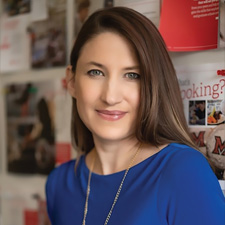
The Time is Ripe

Thought leader shares why higher education marketing matters now

CMO, Old Dominion University
Transformation has been a hallmark of Jaime Hunt’s career. In her 18 years working in higher education, Jaime has been part of four university rebrandings, five website redesigns, and the development of an integrated marketing communications model at two institutions. She has extensive expertise in brand strategy, recruitment marketing, internal communications, crisis communications, issues management, online innovation, and media relations.
Jaime is currently the vice president and chief marketing officer for Old Dominion University, an R1 public research institution located in Norfolk, Virginia. Prior to her current role, Jaime served in marketing and media relations at Miami University, Winston-Salem State University, Radford University, the University of Wisconsin Oshkosh, and Northwestern Health Sciences University. Her background also includes more than four years as a print journalist and three years working for nonprofits and in nonprofit consulting.
Can you share a higher education marketing view of the impending demographic cliff?
The demographic cliff refers to the drop in the number of high school graduates that’s expected around 2025 and 2026. I don’t think higher ed marketers need to panic. They simply need to consider how we expand our markets. And this is the time to start thinking about it because it takes time to build a pipeline that’s attractive to other markets.
There are millions of Americans that haven’t finished their college degrees. They’ve started, but they never graduated. How can we bring them back into the fold? There’s a lot of people that are working adults that want to have degrees who haven’t even started yet. How can we make flexible and convenient options for them? Many of them are working parents or they have full-time jobs that they can’t quit. How can we expand online programs to attract those students?
I think if we look at it as a problem, we might panic and not take proactive steps. But if we look at it as our opportunity, then we have the option to think about higher ed a little bit differently and serve a population that really needs it.
What is a marketer’s response to people questioning the value of higher education?
As marketers, we have to still talk about what the value is and what the takeaways are. We should focus on marketing higher ed not just as a public good, but what people will get from it.
Generation Z is super motivated by entrepreneurial activities like starting side hustles and small businesses. So talking about how they can get the skills and the education to write a good business plan or get investors to grow that business is a good narrative. And if they’re not interested in starting a business, that entrepreneurial thinking will still serve you when you go into the workforce.
“We should focus on marketing higher ed not just as a public good, but what people will get from it.”
– Jaime Hunt, CMO, Old Dominion University
What is your take on Gen Z?
Gen Z is very different from millennials who were very different from Gen X. It seems like Gen Z is much more interested in the values of an institution than previous generations. Recently, I sat in on a panel discussion of 16 and 17 year-olds who were sharing what motivated them and how they ruled out colleges. They talked a lot about accessibility, mental and physical health issues and how open a campus must be for all students.
I think marketers need to be thinking about where Gen Z engages. Over 60% of them use TikTok as a search engine. Therefore, they are not looking for websites with written content. They’re looking for videos that answer their questions about how to fill out FAFSA and how to choose a roommate. So, if higher ed marketers are not in that space, they’re missing a huge opportunity there.
“They [Gen Z] talked a lot about accessibility, mental and physical health issues and how open a campus must be for all students.”
– Jaime Hunt, CMO, Old Dominion University
What is marketing’s place within the administration these days?
There’s been a huge shift over the last 18 years. When I started, we didn’t have a seat at the cabinet level. We were buried in an org chart. Over time, however, savvy presidents started to elevate the role. Clearly, the pandemic accelerated the shift because we were suddenly really important. There is a great need to communicate, persuade, and drive action. So presidents started to pull us into the room and now 73% of marketers have a seat at the cabinet level.
Where do you see growth in higher ed?
It will get hyper-competitive with the demographic change, so schools are investing in new ideas. At Old Dominion University we are making further investments in our online offerings because we think there is a lot of opportunity for growth. We are acknowledging that there will be less opportunity for growth on the traditional undergraduate side. Even at my last institution, I was regularly in meetings with the CFO and the chief enrollment officer to discuss how talking would open up new revenue models for the institution.
Can you share your thoughts on customer versus customer retention in higher ed?
I feel a little remiss that I didn’t mention that when we were talking about the opportunities. The retention question is really important because we lose a ton of students for a variety of reasons, whether it’s financial challenges, fit, or health challenges. At the end of the day, only about half of students who start college actually graduate from college.
Schools can actually grow revenue just by retaining more students year to year. It’s a win-win. Institutions can start to use predictive analytics to monitor students and make sure they can support them. Finding ways to smooth out the obstacles a little bit for students so that they can complete their degree is a win for the institution and a win for the student.


